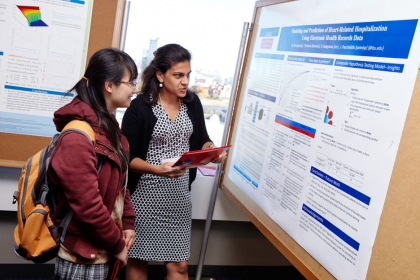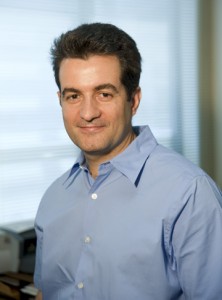By dejoseph
Big Data Improving Health Care
Data scientist and physician team up to reduce preventable hospitalizations
By Suzanne Jacobs, BU Research
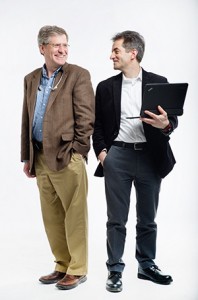
Big Data Meets Healthcare: Bill Adams, a physician and medical informatician, and Yannis Paschalidis, a data scientist and engineer, are working together to use data from electronic health records to reduce preventable hospitalizations and cut health care costs. Photo by Jackie Ricciardi
Big Data Meets Healthcare: Bill Adams, a physician and medical informatician, and Yannis Paschalidis, a data scientist and engineer, are working together to use data from electronic health records to reduce preventable hospitalizations and cut health care costs. Photo by Jackie Ricciardi
Professor Yannis Paschalidis (ECE, SE, BME), a data scientist, has built a career on making things run smoothly and efficiently—transportation systems, communication networks, supply chains, sensor networks—and now he’s taking on perhaps his most ambitious challenge yet: the US health care system.
It all started about three years ago. Paschalidis, a Distinguished Faculty Fellow at Boston University’s College of Engineering (ENG), read in a study by the US Department of Health and Human Service’s Agency for Healthcare Research and Quality (AHRQ) that in 2006, the US spent about $30.8 billion on hospitalizations that could have been prevented through better patient care, healthier patient behavior, or improved ambulatory services.
“I was reading a lot of things about the sorry state of the health care system in the US and how inefficient it is, and I thought it’s an opportunity to do something,” says Paschalidis, who also directs BU’s Center for Information & Systems Engineering. “I thought people like me that have a quantitative, more optimization-oriented background could contribute something.”
And so, having never worked in medicine before, Paschalidis teamed up with William G. Adams, a Boston Medical Center (BMC) physician and BU School of Medicine professor of pediatrics. With a team of graduate students and nearly $2 million from the National Science Foundation, the two set out to build a piece of software that could automatically flag patients at increased risk for medical emergencies by using data from their electronic health records (EHRs). They decided to start with heart diseases, which alone cost the US more than $9.5 billion in preventable hospitalizations in 2006, according to the AHRQ study.
To understand how Paschalidis works, think of how an autopilot controls an airplane. As a plane flies, autopilot software takes in data about its position and uses that data to adjust the plane’s trajectory as necessary. It’s a constant flow of data intake, analysis, and feedback. Similarly, when Paschalidis sets out to improve, say, a network of sensors, he and his research team write computer software that takes in data about how the system is working and then finds ways to correct or improve it.
In this project, hospital patients are the systems.
Fortunately, EHRs offer plenty of data—test results, diagnoses, prescriptions, emergency room (ER) visits, previous hospitalizations, demographic information. It’s far too much for doctors and nurses to comb through manually, but enough to feed an algorithm that automatically processes the information and flags at-risk patients. The software works by sifting through records of patients who were previously hospitalized and learning which risk factor—a certain number of chest complaints or an unusual level of a particular enzyme in the heart, for example—might have been red flags. The algorithm then uses those red flags to warn of future hospitalizations.
The challenge for Paschalidis was understanding how to properly use medical data and how to incorporate this kind of software in an actual hospital. That’s where Adams comes in.
A pediatrician and medical informatician (someone who uses information technology to improve health care), Adams has spent the past 20 years thinking about how to use data from EHRs to improve patients’ health outcomes, especially among families in Boston’s urban communities. He’s also one of the lead scientists at BU’s Clinical & Translational Science Institute (CTSI), one of 60 such sites across the country that aim to accelerate medical advances by encouraging researchers in disparate fields to collaborate on medical research.
“This is a perfect example of translational research collaboration,” Adams says. “Yannis and his lab have exceptional skills in data mining that we don’t have, but we have extraordinary data and clinical expertise.”
To use that data, Paschalidis and his team first needed a crash course in medical terminology to make sure they understood what they were working with. Much of EHR data is contained in a kind of “clinical language” that only doctors understand, Adams says. Sometimes, he says, even the same term can have different meanings, depending on the context in which the doctor records it. For example, a diagnosis of hypertension (high blood pressure) can be recorded as either a diagnosis made during a visit or a problem on the patient’s problem list. Both could be recorded with the same code (ICD-9 401.9), but users would need to know to look further to decide which of the two meanings the data represents. Cleaning up “messy” data—figuring out what it means, what to use, and how to represent it in the software—is time-consuming but important, Paschalidis says. “If you fit garbage to an algorithm,” he says, “you’ll get garbage as output.”
The researchers remove any identifying information from the EHRs using open-source software from a National Institutes of Health-funded center at Harvard University called i2b2 (Informatics for Integrating Biology & the Bedside).
Once the data is cleaned up and anonymized, Paschalidis and his graduate students can enter it into their software. The algorithm they built classifies patients as either at risk or not at risk for heart-related hospitalizations within one year. An elderly patient or someone who visited the ER in the previous year, for example, might be at risk, while a younger person who hasn’t been to the hospital in a few years might not be at risk. How the algorithm will ultimately present this information to doctors is still under development.
To test the software, Paschalidis and his students collected the EHRs of just over 45,500 patients from BMC. They used about 60 percent of the records to train their so-called machine learning software, teaching it which factors had put patients at risk for hospitalizations in the past. Then, they used the remaining data to test the software’s ability to make predictions. They found that it could correctly predict up to 82 percent of heart-related hospitalizations, while falsely predicting hospitalizations in about 30 percent of patients who weren’t actually at risk. Paschalidis says that it’s possible to reduce the number of false predictions, but doing so would correspondingly lower the number of accurate predictions. A false prediction rate of 10 percent, for example, would correspond to an accurate prediction rate of 65 percent.
“In medicine, we’re constantly trying to balance between something that’s concerning and something that might be a false positive,” Adams says. In many cases, however, the recommendations that would come of a false positive—healthy eating, exercise, an extra check-in with the doctor, extra visits from a nurse—could still benefit the patient. And, Paschalidis says, preventing hospital visits that each cost thousands of dollars is worth the occasional unnecessary checkup that only costs a couple hundred dollars.
Adams and Paschalidis published their findings about the machine learning software’s success in predicting heart-related hospitalizations in March 2015 in the International Journal of Medical Informatics. Their co-authors included Professor Venkatesh Saligrama (ECE, SE); Wuyang Dai and Theodora Brisimi, ENG PhD students working with Paschalidis; and Theofanie Mela, a cardiologist at Massachusetts General Hospital.
“If coupled with preventive interventions, our methods have the potential to prevent a significant number of hospitalizations by identifying patients at greatest risk and enhancing their patient care before they are hospitalized,” the researchers write in the study. “This can lead to better patient care, but also to substantial health care cost savings. In particular, if even a small fraction of the $30.8 billion spent annually on preventable hospitalizations can be realized in savings, this would offer significant results.”
Ultimately, Adams says, having this kind of ongoing, automated analysis within electronic medical records could not only help doctors, nurses, and case managers monitor their patients more effectively, it could also elucidate disease risk factors previously undetected by doctors.
“All of us know that a serious problem like diabetes is always going to increase your likelihood of being admitted to the hospital,” Adams says, “but the trick is to determine whether it’s about the thing that’s happening to your diabetes or something else unrelated to your diabetes that has substantially increased the likelihood of being hospitalized. The machine learning software has the potential to learn new associations.” These could be associations between some clinical features that make it more likely for the patient to develop serious complications from diabetes.
In the coming year, Paschalidis and Adams will be interviewing doctors, trying to figure out how best to put this kind of predictive software to work in an actual hospital.
“I’m confident that it will work,” Paschalidis says. “The issue is, what is the best way of incorporating something like that in the practice? Will the doctors use it or ignore it?”
Eventually, Paschalidis says, he’d like to expand the software to predict other, non-heart-related hospitalizations. He’s also currently working with BMC’s surgery department on software designed to flag patients at risk for readmission within 90 days, so hospitals could perhaps monitor those patients more closely. The 90-day window is of particular interest to hospitals because Medicare doesn’t reimburse for readmissions within that timeframe.
Down the road, Paschalidis says, it might also be possible to use data from wearable technologies in addition to EHR data. The data is there, he says; it’s just a matter of getting access to it.
“We carry these smartphones and now these smart watches and all of these fitness trackers and other devices that know much more than the hospital knows about our state of health,” he says. “You now have a much richer record about the patient, and the richer the record is, the better prediction you can make.”
Throughout his career, Paschalidis has put his data analysis skills to use in a lot of different areas. For the past three years, he’s been applying those skills to developing sensor networks for “smart cities.” He says he thinks he’ll be working in health care for a while.
“I feel that health care is an important area,” he says, “and the contributions that you make are somehow more tangible in terms of the potential outcome.”
The story was originally published at BU research and was highlighted as News from the Field by the National Science Foundation.
CISE Hosts International Symposium on Control of Network Systems
Attendees Celebrate New IEEE Journal Edited by ENG’s Paschalidis
By Mark Dwortzan
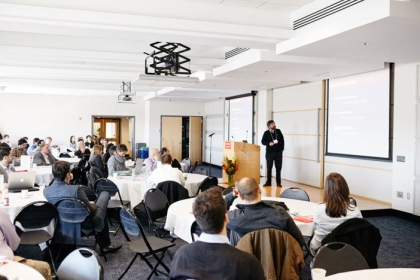
Professor Christos Cassandras (ECE, SE) describing a strategy to maximize battery lifetimes in wireless sensor networks at SCONES, held October 27-28 in the Photonics Center Colloquium Room (Photos by Dave Green)
Microbes are all around us—even inside us—and that’s a good thing. Left alone, these tiny organisms have a huge impact on everything from human health to wastewater treatment. But with a little engineering, they could do even more. In certain environments, their metabolic processes could be exploited to make biofuels, vaccines and other useful products and services. To tap their potential,Associate Professor Daniel Segrè (Biology, BME, Bioinformatics) and collaborators have developed mathematical models to predict the metabolic interactions that occur among different microbial species under varying environmental conditions, and to design new microbial networks with desired properties.
Segrè presented his research at the first Symposium on the Control of Network Systems (SCONES), held on October 27-28 in the Photonics Center Colloquium Room.
Sponsored by the IEEE Control Systems Societyand the Center for Information and Systems Engineering at Boston University, SCONES celebrated the inaugural March 2014 issue of theIEEE Transactions on Control of Network Systems (TCNS), a new IEEE Transactions journal edited by Professor Yannis Paschalidis (ECE, BME, SE) focused on problems related to the control, design, study, engineering, optimization and emerging behavior of network systems.
“We live in a world that is extremely interconnected,” said Paschalidis, the journal’s editor-in-chief. “This is also true of systems, biological or manmade, that support our modern way of life. Networks, which both connect system components and influence how they function as a whole, are increasingly the focus of leading edge research, and this is the impetus forTCNS and SCONES.”
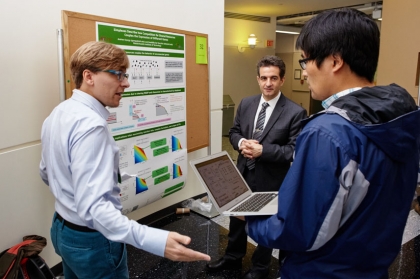
TCNS Editor-in-Chief Professor Yannis Paschalidis (ECE, SE, BME) (center) with MIT PhD student Andras Gyorgy (left) and another SCONES participant (right) during a poster session.
One author of each paper in the inaugural issue presented at the symposium, along with talks and posters from several other researchers in the field. Representing major research institutions from around the world, SCONES presenters explored the analysis, control and optimization of electric power, computer, communication, transportation, biological, cyber-physical, social and economic networks. As if bringing the TCNS journal to life, the 23 featured speakers illustrated complex concepts with a flurry of equations, algorithms, graphs and diagrams.
“TCNS aspires to become the premiere destination for mathematically rigorous work in network systems,” said Magnus Egerstedt, an ECE Professor at Georgia Tech and the TCNS deputy editor-in-chief—and the SCONES presenters lived up to that promise.
In addition to Segrè, two other Boston University researchers shared highlights of papers they co-authored in the inaugural issue of TCNS on resource allocation and routing, the selection of optimal path by which to transmit information across the nodes of a network.
Professor Lev Levitin (ECE, SE) presented an alternative to wormhole routing, a widely used routing technique that’s prone to deadlock—multiple messages getting blocked by one another in a vicious cycle—under heavy computer network traffic. Levitin described a series of new, high-performance algorithms that he, Professor Mark Karpovsky (ECE) and ECE Visiting Researcher Mehmet Mustafa developed to break such cycles and prevent deadlock formation during routing and thus preserve network connectivity.
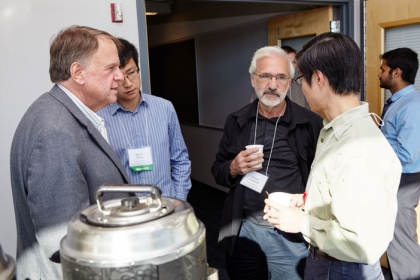
Professor Michael Caramanis (ME, SE) (second from right), who chaired the symposium’s first session on control and optimization of electric power networks, with University of Maryland Professor John Baras (ECE) (left), BU Systems Engineering PhD student Bowen Zhang (second from left) and California Institute of Technology Professor Steven Low (ECE) (right) during a break.
Professor Christos Cassandras (ECE, SE) presented an optimal control strategy that he, Tao Wang (SE, PhD’13) and Sepideh Pourazarm (SE, PhD candidate) devised to maximize the lifetime of sensor batteries deployed at each node of a wireless sensor network for surveillance, environmental monitoring or other applications where human intervention may be inconvenient or costly.
“Because every node has limited energy, you have to worry about the battery dying and the network ceasing to function,” said Cassandras, “so you need to focus on battery lifetime.”
Modeling each battery as a dynamic system in which energy does not dissipate in a linear fashion, the strategy uses an algorithm to determine the routing scheme that will minimize that energy loss.
The symposium, which was well-attended and featured many fruitful exchanges between speakers and attendees, signified how well the TCNS journal has been received by the international research community, Paschalidis observed.
“In the first three TCNS issues published in 2014, we have seen papers covering many types of network systems, from networked control and multi-agent systems, to communication, transportation, electric power, biological and social networks,” he noted. “SCONES is playing a key role in coalescing a community of researchers around the journal.”
IEEE Control Systems Magazine Profile
Yannis Paschalidis was profiled in the June 2014 issue of the IEEE Control Systems Magazine. Read the full story.
Top Ranked ENG Algorithms Could Reveal New Cancer Drug Target
by Mark Dwortzan
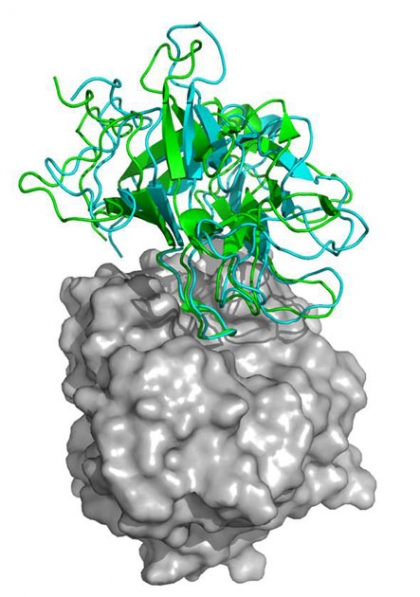
An interdisciplinary College of Engineering team has developed computational methods to predict the structures that form when two cellular proteins interact. Judged the world�s best at a major international competition, these methods have drawn more than $3 million in NIH funding.
An interdisciplinary College of Engineering team has developed computational methods to predict the structures that form when two cellular proteins interact. Judged the world's best at a major international competition, these methods have drawn more than $3 million in NIH funding.
An interdisciplinary team of College of Engineering faculty members—Professor Sandor Vajda and Research Assistant Professor Dima Kozakov (both BME), Professor Ioannis Paschalidis (ECE) and Associate Professor Pirooz Vakili (ME)—has developed a family of powerful optimization algorithms for predicting the structures of complexes that form when two cell proteins bond together—structures that, in some cases, generate erroneous cell signaling pathways that can trigger cancer and other inflammatory diseases. Recognizing the promise of these computational methods to advance new approaches to combating these illnesses, the National Institutes of Health (NIH)-National Institute of General Medical Sciences (NIGMS) recently approved a $1.6 million, five-year grant that will enable the researchers to continue refining them.
A joint effort of Boston University’s Center for Information and Systems Engineering and Biomolecular Engineering Research Center, the project combines Paschalidis’ and Vakili’s expertise in optimization and systems theory with Vajda and Kozakov’s knowledge of biophysics and bioinformatics.
“Given the three-dimensional structure of two proteins, you’d like to predict with great accuracy the structure of the complex formed once these two proteins bind,” said Paschalidis, who compares the process to characterizing all the possible structures that pairs of Lego blocks can form out of an initial set of 1,000 blocks. “Based on laws of thermodynamics, we’ve developed optimization algorithms that have succeeded in doing just that.”
Applying those high-precision algorithms to a related effort, Vajda and Kozakov are also collaborating with BU Associate Professor Adrian Whitty, Professor John Porco, Professor Karen Allen, and Research Assistant Professor Aaron Beeler (all Department of Chemistry); and Professor Gilmore (Department of Biology) to identify small molecules—potential drugs—that can disrupt protein-protein interactions (PPIs) that produce structures that may provoke illness.
Operating under a separate, four-year, $1.6 million NIH-NIGMS grant, the BU team aims to develop synthetic molecules that inhibit PPI targets at sites identified by Vajda’s and Kozakov’s innovative computational approaches—without introducing any harmful side effects. In particular, the researchers are attempting to design novel molecules that can block chronically hyperactive cell signaling pathways found in human inflammatory diseases and cancers.
Despite decades of effort by the pharmaceutical industry, it has proven extraordinarily difficult to develop oral drugs that inhibit PPIs, Vajda observed. “Current protein-based drugs can disrupt PPIs, but only on the surface of cells,” he said. “But 90 percent of PPIs occur within the cell, and these are the interactions that we’re working to disrupt.”
ENG Algorithms Judged the World’s Best
The NIH is funding the development and application of these advanced computational methods because scientists cannot easily observe the complexes formed by protein-protein interactions. Many biologically important PPIs produce fragile complexes that do not remain intact long enough to be subject to direct experimental analysis, but optimization algorithms such as those developed by the ENG team can determine the structure of these complexes with great accuracy based on the structures of the component proteins.
As the team improves its methods, they will ultimately be incorporated into Vajda’s and Kozakov’s protein-protein docking server ClusPro, a website to which any user can submit the three-dimensional coordinates of two proteins and receive a supercomputer-calculated prediction of the structure of the complex formed by those proteins. ClusPro has been used by over 3000 research groups worldwide, and generated over 100 structures reported in the scientific literature.
In a worldwide blind prediction experiment conducted by CAPRI (Critical Assessment of Predicted Interactions) in Barcelona last December, judges determined that the ENG team’s computational methods delivered the best performance in modeling selected protein-protein complexes when compared against 64 other predictor groups that combine software models with human analysis, and that ClusPro also performed better than nine other competing automated docking servers, which rely on software alone. Results of the CAPRI experiment will be published in a special issue of the journal Proteins: Structure, Function, and Bioinformatics in November.
Interdisciplinary Team Sheds Light on How Proteins Bind
Finding Could Open Up New Drug Discovery Opportunities
By Mark Dwortzan
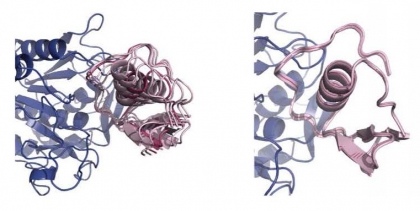
"Transient encounter complexes" of an enzyme produced by a bacterium present in the human gut binding to a fragment of a protein in turkey eggs which inhibits the enzyme.
Over the past six years, an interdisciplinary team of College of Engineering faculty members—Professor Sandor Vajda (BME, SE), Research Assistant Professor Dima Kozakov (BME), Professor Yannis Paschalidis (ECE, SE) and Associate Professor Pirooz Vakili (ME, SE)—have been developing a set of powerful optimization algorithms for predicting the structures of complexes that form when two proteins bind together—structures that, in some cases, generate erroneous cell signaling pathways that can trigger cancer and other inflammatory diseases.
Incorporated into Vajda’s and Kozakov’s protein-protein docking server ClusPro—a website to which any user can submit the three-dimensional coordinates of two proteins and receive a supercomputer-calculated prediction of the structure of the complex formed by those proteins—these algorithms have enabled more than 3,000 research groups across the globe to better understand the inner-workings of the cell and explore potential drug targets without having to run expensive, time-consuming lab experiments.
Now the research team behind these algorithms has, through lab experiments and computational analysis, obtained a sharper understanding of how two proteins come together to form a complex, and plans to apply that knowledge to boost the speed and accuracy of ClusPro’s predictions. They and collaborators from the Hebrew University of Jerusalem and the National Institutes of Health (NIH) report on this new development in a new article in eLife, an open source journal for outstanding biomedical research.
A joint effort of Boston University’s Center for Information and Systems Engineering and Biomolecular Engineering Research Center supported by a five-year, $1.6 million grant from the NIH, the project combines Paschalidis’ and Vakili’s expertise in optimization and systems theory with Vajda and Kozakov’s knowledge of biophysics and bioinformatics.
“The research was a beautiful combination of physics with mathematics,” said Paschalidis. “We leveraged techniques popular in control systems developed to describe movement of complex 3-D objects, such as a robot arm, as well as machine learning methods used to analyze large data sets.”
“Preventing proteins from binding to the wrong partners is an increasingly prominent concept in drug design,” said Janna Wehrle, PhD, of the NIH National Institute of General Medical Sciences, which partially funded the research. “These new computational methods developed by the Boston University team will help researchers quickly discover both healthy protein pairs and disease-causing pairs that we might want to break up.”
Until now, scientists were unable to characterize how protein-protein complexes form from two individual proteins—each analogous to a distinctly-shaped Lego block—because their interactions from the moment they come in contact to the moment they “snap into place” were too fast to detect. But an emerging nuclear magnetic resonance (NMR) technique has made it possible to track their rapidly changing configurations from rendezvous to docking using radio waves.
Applying this technique, the College of Engineering team determined that its protein-protein docking algorithms were already generating these exact transitional states, but labelling them as “false positives” alongside the correctly identified final protein-protein complex.
“What we have so far been calling false positives are ‘transient encounter complexes,’ temporary structures the proteins form as they ‘search’ for the one orientation that will enable them to bind successfully,” said Paschalidis.
All protein-protein encounter complexes are characterized by low energy, with the lowest energy expected to occur at the final, stable complex. By systematically analyzing the energy values corresponding to the transient complexes, the researchers found that with each successive interaction, the intersecting proteins have fewer and fewer ways to twist and turn, thereby accelerating their path to binding. This explains how two proteins can dock very quickly despite the many nooks and crannies that must line up to seal the deal.
The College of Engineering team next aims to exploit its findings to make its docking algorithms faster and more accurate. The researchers also plan to examine the implications of their work for protein-DNA and protein-small molecule interactions that are important in genetic regulation and drug discovery, respectively.
See movie of transient protein-protein encounter complexes.
Three ECE Profs Named as IEEE Fellows
Professors W. Clem Karl (ECE, BME, SE), Theodore Moustakas (ECE, MSE) and Yannis Paschalidis (ECE, SE) have been named as 2014 IEEE Fellows, the highest grade of membership in the world’s leading professional association for advancing technology for the benefit of society.
The IEEE confers the grade of Fellow upon individuals with outstanding records of accomplishment in any of the organization’s fields of interest, which range from aerospace systems, computers and telecommunications to biomedical engineering, electric power and consumer electronics. Less than 0.1 percent of voting members—the IEEE currently has 400,000 members in 160 countries—are selected annually for this member grade elevation, considered a major career achievement and prestigious honor across the technical community.
W. Clem Karl
Karl was recognized for his contributions to “statistical signal processing and image reconstruction.” He hasdeveloped several statistical models for the extraction of information from diverse data sources in the presence of uncertainty, and applied them in projects that include automatic target detection and recognition for synthetic aperture radar; locating oil deposits and analyzing the earth’s atmosphere; and monitoring medical conditions using tomography and MRI.

“This is a great honor, and I’m humbled that my peers would confer it on me,” said Karl.
A member of the BU faculty since 1995, Karl has assumed many leadership roles for the IEEE. Currently editor-in-chief of IEEE Transactions on Image Processing, he is a member of the Board of Governors and Conference Board of the Signal Processing Society; the Transactions on Medical Imaging Steering Committee; the Biomedical Image and Signal Processing Technical Committee; and the Technical Committee Review Board. He has co-organized IEEE workshops on statistical signal processing and bioinformatics, and was general chair of the 2009 IEEE International Symposium on Biomedical Imaging.
Among other things, Karl is developing methods to improve the detection of explosives in luggage. The technology could increase passenger safety while reducing delays and other inconveniences for air travelers, such as having to remove laptops and other electronic devices from bags.
Theodore Moustakas
Moustakas was recognized for his contributions to “the epitaxial growth of nitride semiconductors.” He is a trailblazer in molecular beam epitaxy, a versatile and advanced thin-film growth technique used to make high-precision, nitride (nitrogen compound-based) semiconductor materials used in fiber-optic, cellular, satellite and other applications.

His most notable achievements include pioneering the nucleation steps for the growth of gallium nitride on sapphire and other substrates, an essential process for the manufacture of blue LEDs, which are widely used in solid state lighting applications; and developing highly-efficient, deep ultraviolet (UV) LEDs, which are expected to provide environmentally friendly water and air purification.
“I am delighted to receive this prestigious award and I am very grateful to many of my collaborators at BU and other institutions, as well the outstanding past and current students that I have had the fortune of mentoring,” said Moustakas.
A member of the ENG faculty for more than 30 years and ENG Distinguished Scholar who helped shape the Materials Science & Engineering Division, Moustakas has had a broad impact on his field, through 25 patents, hundreds of invited talks and journal papers and 10,000 citations in research literature. Recently selected as the recipient of the Molecular Beam Epitaxy (MBE) Innovator Award, he is also a Fellow of the American Physical Society and Electrochemical Society, and Charter Fellow of the National Academy of Inventors. In 2013 he was named the Boston University Innovator of the Year.
Moustakas is currently working to create visible and UV LEDs and lasers for solid-state white lighting, water and air sterilization, and identification of biological and chemical agents; investigating indium gallium nitride “quantum dots” that boost solar cell efficiency; and, in collaboration with Associate Professor Roberto Paiella (ECE, MSE), studying the use of nitride semiconductor structures for green LED applications and for emitters and detectors operating in the far infrared.
Yannis Paschalidis
Paschalidis was recognized for his contributions to “the control and optimization of communication and sensor networks, manufacturing systems and biological systems.” Since joining the College of Engineering faculty in 1996, he has developed sophisticated algorithms for everything from a homeland security early warning sensor network to a next-generation electronic healthcare management system.

“I am elated to have been named an IEEE Fellow,” said Paschalidis. “Much credit is due to all my students and postdoctoral associates, past and present, who have contributed to the work being recognized, and all my collaborators, many of them here at Boston University.”
Co-director of the College’s Center for Information and Systems Engineering (CISE), an ENG Distinguished Faculty Fellow and affiliate of the BioMolecular Engineering Research Center, Paschalidis has a diverse research portfolio that spans the fields of systems and control, networking, applied probability, optimization, operations research, computational biology and bioinformatics. His work has resulted in new applications in communication and sensor networks, protein docking, logistics, cyber-security, robotics, the smart grid and finance.
Paschalidis has received several honors, including a CAREER award from the National Science Foundation, an invitation to participate in the National Academy of Engineering Frontiers of Engineering Symposium, two best paper awards, and best performance at a computational biology competition. He is the editor-in-chief of the IEEE Transactions on Control of Network Systems and a member of the Board of Governors of the IEEE Control Systems Society.
Visiting Professor Vivek Goyal (ECE), who will be an assistant professor in the ECE Department starting in January, was also named an IEEE Fellow.
Dedicated to the advancement of technology, the IEEE publishes 30 percent of the world’s literature in the electrical and electronics engineering and computer science fields, and has developed more than 900 active industry standards. The association also sponsors or co-sponsors nearly 400 international technical conferences each year.
BU, research universities hit by international cyber attacks
Written by Drew Schwartz
One of Boston University’s public web pages suffered a cyber attack from an unidentified, internationally-based source last week, said BU’s Information Security Team Executive Director Quinn Shamblin.
Shamblin said the attack was directed at the search bar function on one of BU’s web pages. He said the attack caused the web page’s service to slow down, but there was no indication whether the indivdiual or group responsible stole any of BU’s information.
“It [the attack] was a particular group having found a form on BU servers,” Shamblin said. “They were trying to see if they could get that form to give them information that they shouldn’t have had.”
A cyber attack is any event where an external agency or person tries to use or gain access to resources in an unauthorized way, Shamblin said. Cyber attackers usually target the intellectual property of governmental, corporate or university web pages.
After a barrage of cyber attacks hit American research universities this past summer, campuses across the nation have been forced to tighten Internet security measures, according to a July article in The New York Times. Shamblin said BU’s network occasionally such cyber attacks, and that InfoSec utilizes several defense techniques to ensure the university’s information is secured.
“We get attacks all the time because that’s just how the Internet works,” Shamblin said. “We [InfoSec] work with the FBI [Federal Bureau of Investigation] … U.S. Secret Service … local law enforcement as needed … We will call them as appropriate with full cooperation of our general counsel and appropriate other groups inside of the university.”
Shamblin said BU students and faculty should keep their computers’ operating systems updated to defend themselves against these attacks.
“We want to make sure that if somebody wants to try to get access to sensitive information — or wants to try to break into your personal machine — they have to go through multiple layers of security,” Shamblin said. “The point of it is to make it such a pain in the butt that they [cyber attackers] won’t waste their time, and they’ll go somewhere else.”
Christos Cassandras, head of BU’s Divisions of Systems Engineering said, although BU’s InfoSec department successfully stopped last week’s cyber attack, they may not always know when their system is being attacked.
“It could be that somebody had sent those malicious [programs] into your computer two weeks ago, and you still don’t know anything about it,” Cassandras said. “There are so many different ways [to execute cyber attacks] and new ones are being invented every day. It’s a little bit like the Cold War … As soon as somebody discovers a new weapon, we find out the counter to this weapon.”
Cassandras said although university officials have taken measures to ensure the safety of their servers, unattended computers at BU are highly vulnerable to attackers.
“The biggest threat, I think, is that we have a lot of computers in universities, including BU, that are sitting around in labs and doing things without continuous supervision,” Cassandras said. “During that time that the computer isn’t being supervised, someone can take over that computer.”
Ionnas Paschalidis, co-director of BU’s Center for Information and Systems Engineering, said cyber security is a growing concern for universities such as BU that are involved in classified research.
“The vast majority of research at universities eventually is being made public …. But before they publish, they don’t want their research to be made public,” Paschalidis said. “It’s a growing concern not only in universities, but throughout our society as we depend much more on services that are online … Every aspect of our lives is now connected to a network one way or the other. This creates much more serious consequences for cyber-attacks.”
Interview with I. Paschalidis- IEEE Transactions on Control of Network Systems
Interview taken from IEEE Control Systems Magazine, Oct. 2013
In this column, we speak with Ioannis (Yannis) Paschalidis, who is the editor-in-chief of IEEE Transactions on Control of Network Systems. Yannis is a professor and Distinguished Faculty Fellow in the College of Engineering at Boston University with a joint appointment in the Department of Electrical and Computer Engineering and the Division of Systems Engineering, and he is a codirector of the Center for Information and Systems Engineering. He received M.S. and Ph.D. degrees in electrical engineering and computer science at the Massachusetts Institute of Technology in 1993 and 1996, respectively, before joining Boston University.
Q. Congratulations on your new role as the inaugural editor-in-chief of IEEE Transactions on Control of Network Systems (TCNS). What will be the scope of this transactions and its distinct role in both the IEEE Control Systems Society (CSS) and in other communities?
Yannis: Thank you! I am honored to be named the editor-in-chief of TCNS. I am also excited to have Magnus Egerstedt as the deputy editor-inchief. TCNS is sponsored by the CSS, and technical cosponsors include the IEEE Circuits and Systems, Communication, Computer, and Robotics and Automation Societies. This broad support reflects the desire for TCNS to be at the interface of several disciplines that contribute to network systems research and attract papers not only from CSS but also from a number of other communities. TCNS will publish high-quality papers on systems with interconnected components. The primary interest is in problems related to the control of network systems, but TCNS is also open to contributions concerning network systems design, study, engineering, optimization, and emerging behavior since these considerations can inform and guide design and control. Rigorous methodological/theory papers on network systems and application papers that have a significant degree of modeling or methodological novelty in some application area of network systems are of interest. Application areas are many, spanning engineered systems, social science, economics, and biological systems. Examples of potential application domains include network control systems, communication networks, sensor networks, cyberphysical systems, networks of autonomous agents, electric power networks, transportation networks, biological networks, and social and economic networks. The scope is broad with interest in papers that make novel contributions to network systems, irrespective of the target application area. TCNS has a distinct role within the portfolio of CSS-sponsored publications. IEEE Transactions on Automatic Control serves as the premier repository of new results in control theory, while IEEE Transactions on Control Systems Technology covers technological advances in the design, realization, and operation of control systems. On the other hand, IEEE Control Systems Magazine is distinct in its publication of tutorials, essays, and reports on a variety of CSS and related activities. TCNS aims to provide a focused venue for rigorous work in network systems and to become the premier journal for this emerging and growing area that extends well beyond the “boundaries” of the CSS. Although other journals exist that cover specific application domains of networks (e.g., communication or sensor networks), there is no journal with TCNS’s emphasis on rigorous contributions targeting the control of network systems with potentially very broad coverage of application domains. It is commendable that CSS, through its Executive Committee, showed good judgment and vision in launching TCNS. Much credit is due to the immediate CSS past president, Christos Cassandras, and the immediate Past Vice President of Publications Frank Doyle, who spearheaded this effort and were instrumental in obtaining IEEE approval. A number of CSS technical committees (TCs), including the TC on Networks and Communications, have contributed in forming the vision that led to TCNS. The current Executive Committee, led by CSS President Yutaka Yamamoto and Vice President of Publications Francesco Bullo, have also been extremely helpful during this initial stage.
Q. What are your plans for the inaugural issue?
Yannis: We plan to publish the inaugural issue in March 2014. TCNS will be published quarterly. The submission site opened in July 2013, with a deadline of September 20, 2013 for papers to be considered for the inaugural issue. TCNS will publish one type of paper (no brief papers or technical notes for the time being). All papers submitted to the inaugural issue will undergo regular review. Authors of accepted papers will be invited to present their work at a Symposium on Control of Network Systems, which will take place in Boston in March 2014. This symposium will celebrate the launch of TCNS, and it will also help a community coalesce around the publication. We hope that this community will reflect the broad scope of the journal. Details are available at the journal Web site (http://sites.bu.edu/tcns). We are currently in the process of appointing an editorial board. I am elated to report that, as of this writing, we have commitments from an amazing editorial board that was unanimously endorsed by the CSS Executive Committee. CSS Board of Governors approval was granted in early June 2013, and then the board was announced on the TCNS Web site. The board reflects the broad scope of TCNS and consists of four senior editors and about 20 associate editors. We plan to be aggressive in enforcing review deadlines, and we are setting a target for decisions to be taken no later than three months from submission. Rapid publication of accepted papers is an important goal, and we will work tirelessly toward it.
Q. What kind of guidance can you provide to authors who may wish to contribute a paper?
Yannis: The paper should describe a new, previously unpublished, and interesting contribution to network systems. The editorial board will evaluate whether the contribution is interesting and potentially relevant to answering a fundamental question in network systems or relevant to some application domain. We subscribe to the view that being able to solve a problem with correct mathematics does not necessarily imply that the problem is worth solving. The work must be interesting, relevant, and have the potential to attract readers. We will also pay attention to the quality of the exposition. The paper should be readable, succinct, and accessible to non-experts in the very narrow technical subfield.
Q. This is an exciting beginning of a new CSS publication. I am looking forward to seeing how this publication develops.
Yannis: We are too. We aspire for TCNS to assume a central role within the burgeoning community of network systems. Thank you for this opportunity to reach out to IEEE Control Systems Magazine readers.
Better Data Management, Lower Healthcare Costs
By Rachel Harrington
Today, people with chronic conditions like diabetes are benefitting from real-time monitoring devices like miniaturized implants, home monitoring equipment, and smartphone applications. Unfortunately, even though tracking a person’s symptoms and vitals has improved, hospitals and their medical teams are not ready to benefit from possessing so much personalized health data.
Boston University’s Professor Ioannis Paschalidis (ECE/SE)and Dr. William Adams (BMC) have teamed up with MIT’s Professor Dimitris Bertsimas to develop algorithms that can systematically process all patient data in hospital electronic medical records and personalized health records. These algorithms will be designed to classify patients based on the risk of developing an acute condition that would require hospitalization. Such information can then be used to drive preventive actions.

“What motivated us to start this particular project is the recognition that the US health care system is extremely inefficient as it is geared toward treating acute conditions,” said Paschalidis. “There are, we believe, tremendous opportunities for preventing the occurrence of these conditions and the expensive hospitalizations they cause.”
To support their work, the National Science Foundation (NSF) has awarded Paschalidis (PI), Adams (Co-PI), and Bertsimas (Co-PI) a five-year, nearly $2 million grant for the project.
By focusing on disease prevention and keeping patients out of the hospital, their work has the potential to improve a healthcare system that is often considered to be very expensive and highly inefficient.
“To that end, the meaningful use of electronic health records is seen as a key to improving efficiency,” the team wrote in their proposal.
The research will utilize Paschalidis’s expertise in data models, optimization and decision theory, but it is truly a collaborative project. Adams, for example, will work with physicians to get feedback on the outcome of the algorithms.
“The main challenge is going to be the adoption of the techniques we develop by physicians in particular and the healthcare system in general,” Paschalidis said. “Dr. Adams will serve as our ambassador to that community.”
Adams said that the Boston Medical Center has spent more than ten years “developing a robust and rich clinical informatics infrastructure for clinical care and research” and welcomes this new partnership.
“Translational science involves collaborative efforts between traditionally independent scientists,” Adams said. “This project is innovative and important in that it brings together mathematicians, engineers, clinicians, and informaticians to better understand and improve healthcare.”
As healthcare costs increase, their research may prove not only to be timely but also life-changing and cost-effective.
SE/ECE/CS Team Wins $1M NSF Grant with UMass and UConn for “Smart City” Research
A team of faculty led by Christos Cassandras (SE-ECE, Head of SE Division) with Yannis Paschalidis (SE-ECE, Co-Director of CISE), Azer Bestavros (CS) and Assaf Kfoury (SE-CS) has won a major new NSF grant to support their research project: A Cyber-Physical Infrastructure for the Smart City.

The project aims at making cities “smarter” by engineering processes such as traffic control, efficient parking services, and new urban activities such as recharging electric vehicles. To that end, the research will study the components needed to establish a Cyber-Physical Infrastructure for urban environments and address fundamental problems that involve data collection, resource allocation, real-time decision making, safety, and security. Accordingly, the research is organized along two main directions: (i) sensing and data acquisition using a new mobile sensor network paradigm designed for urban environments; and (ii) decision support for the “Smart City” relying on formal verification and certification methods coupled with innovative dynamic optimization techniques used for decision making and resource allocation. The work will bring together and build upon methodological advances in optimization under uncertainty, computer simulation, discrete event and hybrid systems, control and games, system security, and formal verification and safety.
Target applications include: a “Smart Parking” system where parking spaces are optimally assigned and reserved, and vehicular traffic regulation. The research has the potential of revolutionizing the way cities are viewed: from a passive living and working environment to a highly dynamic one with new ways to deal with transportation, energy, and safety. Teaming up with stakeholders in the Boston Back Bay neighborhood, the City of Boston, and private industry, the research team expects to establish new collaborative models between universities and urban groups for cutting-edge research embedded in the deployment of an exciting technological, economic, and sociological development.
This is a collaborative research project with UMass and UConn. The investigators outside BU include: Weibo Gong (UMass Amherst) and Robert Gao (UConn). The award totals $1M ($700K to BU + $150K to UMass + $150K to UConn). Congratulations to the whole team!
